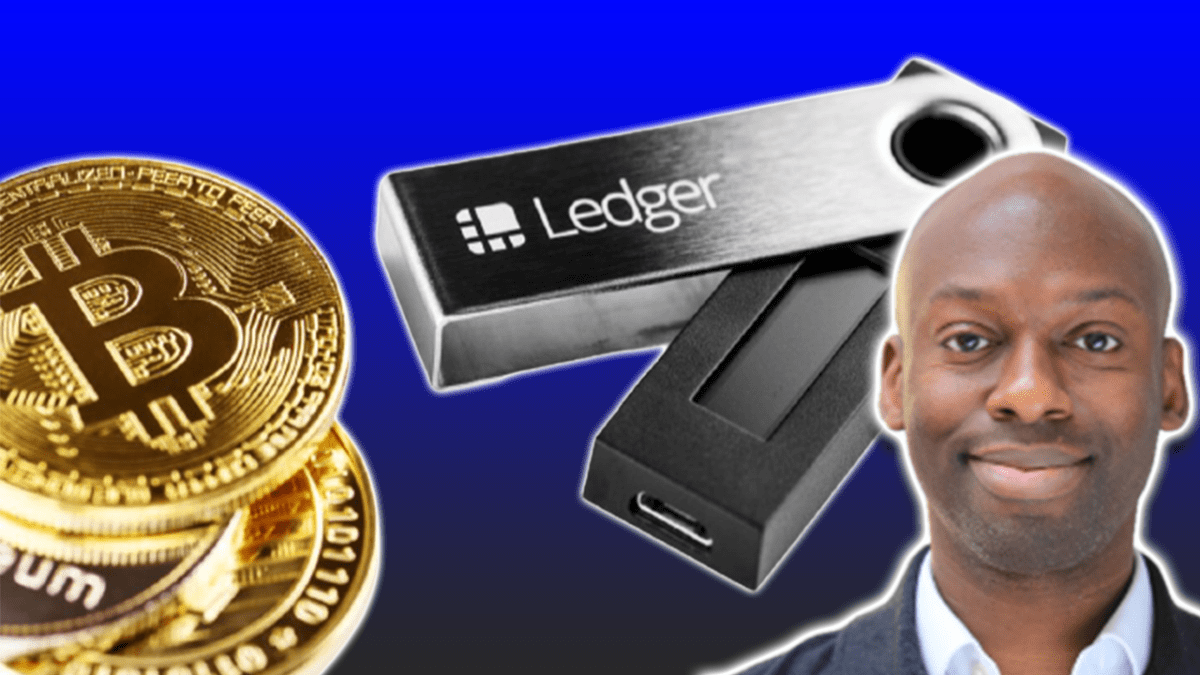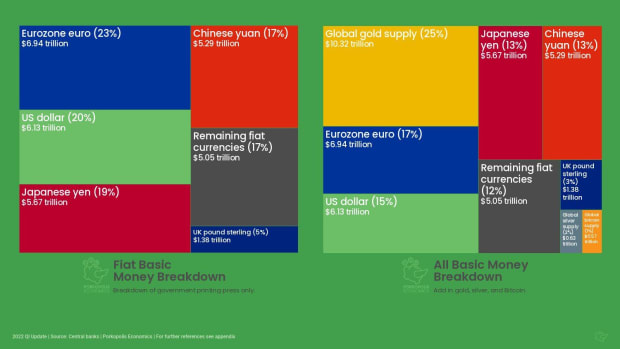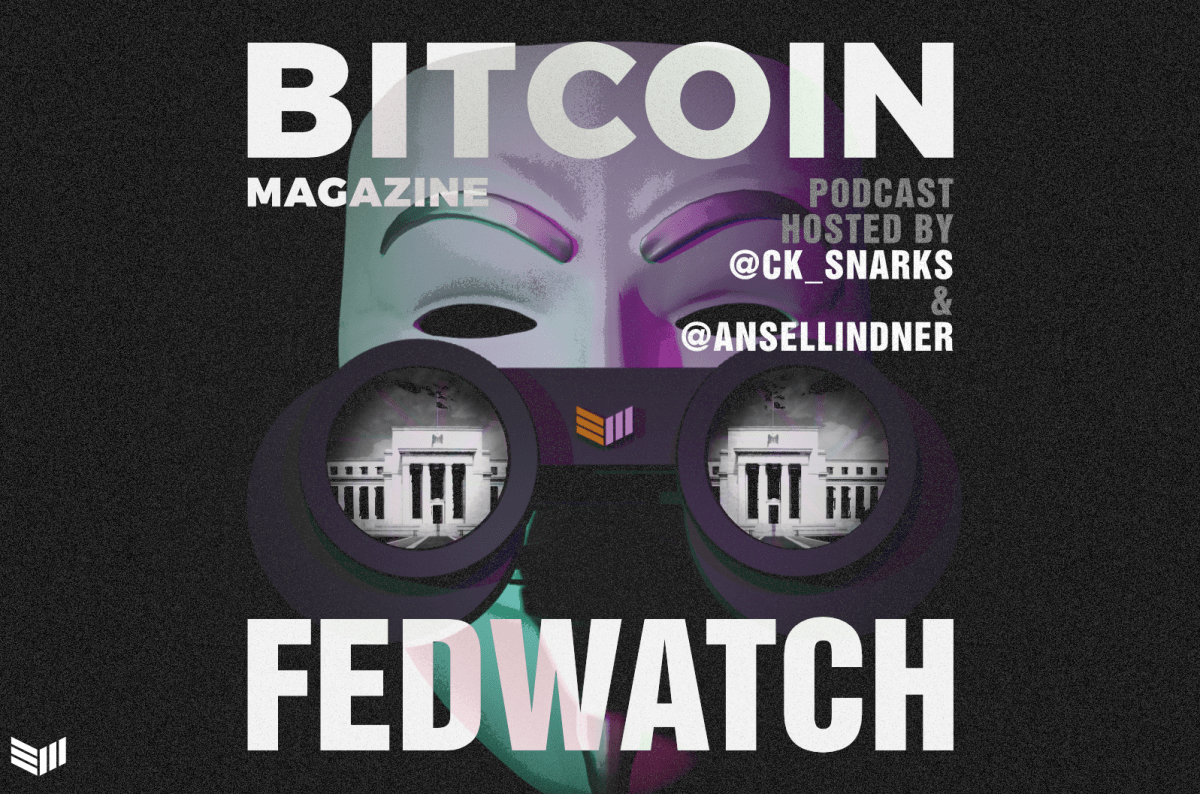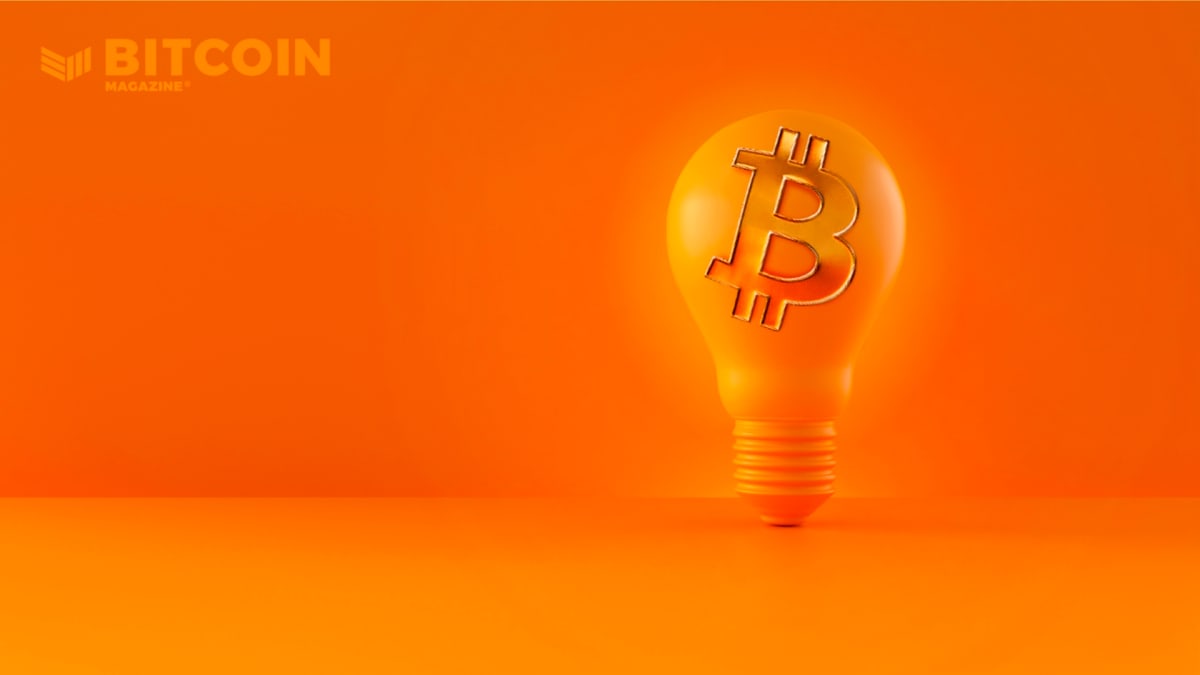The world’s reserve currency relies on oil, dictators, inequality and the military-industrial complex. But a Bitcoin standard could change this.
In its growth from conceptual white paper to trillion-dollar asset, Bitcoin has attracted an enormous amount of criticism. Detractors focus on its perceived negative externalities: energy consumption, carbon footprint, lack of centralized control and inability to be regulated. Regardless of the validity of these arguments, few critics stop to think comparatively about the negative externalities of the world’s current financial system of dollar hegemony.
This is, in part, because many Bitcoin critics see it as just a Visa-like payment platform, and analyze its performance and costs by “transactions per second.” But Bitcoin is not a fintech company competing with Visa. It is a decentralized asset competing to be the new global reserve currency, aiming to inherit the role gold once had and the role the dollar holds today.
The world relies on the U.S. dollar and U.S. treasuries, giving America unparalleled and outsized economic dominance. Nearly 90% of international currency transactions are in dollars, 60% of foreign exchange reserves are held in dollars and almost 40% of the world’s debt is issued in dollars, even though the U.S. only accounts for around 20% of global GDP. This special status that the dollar enjoys was born in the 1970s through a military pact between America and Saudi Arabia, leading the world to price oil in dollars and stockpile U.S. debt. As we emerge from the 2020 pandemic and financial crisis, American elites continue to enjoy the exorbitant privilege of issuing the ultimate monetary good and numéraire for energy and finance.
The past few decades have seen a vast global rise in economic activity, population, democratic progress, technological advancement and living standards, but there are many flaws in this system that are rarely spoken about and that weigh heavily on billions of people across the globe.
What would the world look like with an open, neutral, predictable base money instead of one controlled and manipulated by one government representing only 4% of the planet’s population? This article explores the seldom discussed and staggering downsides of the current system in the hope that we can replace it with something more fair, free and decentralized.
This essay will explore the rarely discussed creation of the petrodollar and lay out how America has supported brutal dictators, compromised its national security, harmed its industrial base, propped up and protected the fossil fuel industry and even waged conflict abroad, all to bolster the dollar’s status as global reserve currency. While this strategy worked for U.S. leaders for many decades, today the world is inexorably moving to a more multipolar financial structure, and possibly, towards a Bitcoin standard.
I. Birth Of The Petrodollar
The British Empire was the unquestioned economic hegemon of the 19th century, but began to lose steam early in the 20th century, especially after World War I. The United States emerged much healthier than war-torn Europe and as the country with by far the most gold. By the outbreak of World War II, the dollar had unquestionably eclipsed the pound as the world’s most influential national currency.
Governments still relied on gold as the underlying global reserve currency, but U.S. and U.K. policymakers were determined to create a more “flexible” system. In the waning months of World War II, leaders from 44 countries gathered in a hotel in Bretton Woods, New Hampshire, to choose a new financial bedrock. British economist John Maynard Keynes pushed the idea of the bancor, a global unit of account that many nations would manage. But the U.S. preferred the idea of the dollar at the center, pegged to gold at $35 per ounce. Since international trade deficits still had to be settled in gold, America’s substantial control of the world’s gold supply and favorable balance of payments position provided the leverage to get its way.
Over the coming decades, the world shifted to the Bretton Woods standard, with national currencies pegged to adjustable dollar amounts, where the U.S. was trusted to custody and hold enough gold to prop up the whole system. Up until the early 1960s, it did a reasonably good job. Dollars became the dominant medium of exchange for international settlement, backed by a promise to pay in gold. America became the largest creditor nation and an economic powerhouse. However, after the assassination of President Kennedy, the U.S. government chose a path of huge social and military spending. With President Johnson’s “great society” social programs and the invasion of Vietnam, U.S. debt skyrocketed. Unlike World War II or the Korean War, Vietnam was the first American war waged almost entirely on credit.
As Niall Ferguson wrote in “Ascent Of Money,” “In the late 1960s, U.S. public sector deficits were negligible by today’s standards, but large enough to prompt complaints from France that Washington was exploiting its reserve currency status to collect seigniorage from America’s foreign creditors by printing dollars, much as medieval monarchs had exploited their monopoly on minting to debase the currency.”
French economist Jacques Reuff called this the “monetary sin of the West,” and the French government coined the term “exorbitant privilege.” Poor British fiscal policy forced a devaluation of the pound in 1967, and the French, fearing that unsustainable American spending would result in similar negative results, wanted its gold back before a dollar devaluation.
By 1971, U.S. debt had simply grown too high. Just $11 billion in gold backed $24 billion in dollars. That August, French President Pompidou sent a battleship to New York City to collect his nation’s gold holdings from the Federal Reserve, and the British asked the U.S. to prepare $3 billion worth of gold held in Fort Knox for withdrawal. In a televised speech on August 15, 1971, President Richard Nixon told the American people that the U.S. would no longer redeem dollars for gold as part of a plan that included wage and price freezes and an import surcharge in an attempt to save the economy. Nixon said closing the gold window was temporary, but few things are as permanent as temporary measures. As a result, the dollar was devalued by more than 10%, and the Bretton Woods system ceased to exist. The world entered a major financial crisis, though when asked about the impact that the “Nixon Shock” would have on foreign nations, Nixon made his position clear: “I don’t give a shit about the lira.”
As David Graeber wrote in “Debt,” “Nixon floated the dollar in order to pay for the cost of a war in which he ordered more than four million tons of explosives and incendiaries dropped on cities and villages across Indochina… the debt crisis was a direct result of the need to pay for the bombs, or, to be more precise, the vast military infrastructure needed to deliver them. This was what was causing such an enormous strain on U.S. gold reserves.”
For the first time in history, the world was in a pure fiat standard. The dollars held by central banks across the globe lost their backing, and there was a geopolitical moment where U.S. dominance was called into question and where a multipolar financial world was a distinct possibility. Adding even more pressure, in 1973 the Arab petroleum exporters of OPEC decided to quadruple the price of world oil and embargo the U.S. in response to its support for Israel during the Yom Kippur War. In just a few years, a barrel of oil rose from less than $2 to nearly $12. Faced with double-digit inflation and declining global faith in the dollar, Nixon and his Secretary of State and National Security Advisor Henry Kissinger came up with an idea that would allow them to keep “guns and butter” going in the post-gold standard era and alter the fate of the world.
In 1974, they sent new Treasury Secretary William Simon to Saudi Arabia “to find a way to persuade a hostile kingdom to finance America’s widening deficit with its newfound petrodollar wealth.” Simply put, a petrodollar is a U.S. dollar paid to a petroleum exporter in exchange for oil. As a Bloomberg report says, the basic framework was “strikingly simple.” The U.S. would “buy oil from Saudi Arabia and provide the kingdom military aid and equipment. In return, the Saudis would plow billions of their petrodollar revenue back into Treasuries and finance America’s spending.” This was the moment that the U.S. dollar was officially married to oil.
On June 8, 1974 in Washington, Kissinger and Crown Prince Fahd signed agreements establishing Saudi investment in the U.S. and American support for the Saudi military. Nixon flew to Jeddah a few days later to continue working out details. Declassified documents later revealed that the U.S. government confidentially enabled the Saudis to purchase treasuries “outside regular auctions and at preferential rates.” In early 1975, they purchased $2.5 billion of treasuries, beginning a spree that would later become hundreds of billions of petrodollars invested in U.S. debt. Decades later, Gerry Parsky, who was deputy to Treasury Secretary Simon at the time, said that this “secret arrangement with the Saudis should have been dismantled years ago,” and that he was “surprised the Treasury kept it in place for so long.” But even so, he said he “has no regrets” since “doing the deal was a positive for America.”
By 1975, other OPEC nations followed Saudi Arabia’s lead. If you wanted to buy oil from them and their store of nearly 80% of world petroleum reserves, you had to pay in dollars. This created new demand for America’s currency at a time of global uncertainty and even at a time of continued inflation. Industrializing nations needed oil, and to get it, they now had to either export goods to the United States, or buy dollars in foreign exchange markets, increasing the dollar’s global network effect. In 1974, 20% of global oil was still transacted in the British pound, but that number fell to 6% by 1976. By 1975, Saudi imports of U.S. military equipment had risen from $300 million to more than $5 billion. Oil prices, boosted by the premium that came with being able to be sold for dollars, would remain sky-high until 1985.
II. Impact Of The Petrodollar
In his research on the petrodollar, political economist David Spiro argues that OPEC dollar profits were “recycled” into U.S. treasuries to subsidize the “debt-happy policies of the U.S. government as well as the debt-happy consumption of its citizenry.” Petrodollar recycling over time pushed down interest rates and allowed the U.S. to issue debt very cheaply. This system was created and held in place not by pure economics but by politics through the pact with Saudi Arabia. As Alan Greenspan said in 1977, reflecting on his experience as chairman of the Council of Economic Advisers during the Ford administration, the Saudis were “non-market decision-makers.”
Graeber points to petrodollar recycling as an example of how U.S. treasuries replaced gold as the world’s reserve currency and ultimate store of value. The kicker, he explains, was that “over time, the combined effect of low interest payments and inflation is that these bonds actually depreciate in value… economists prefer to call it ‘seigniorage.’”
Since its creation in 1974, the petrodollar system has changed the world in many significant ways, including:
- The creation of a tight alliance between the United States and the Saudi Arabian dictatorship, as well as other tyrannies in the Gulf region.
- The steep rise of the “eurodollar” shadow global economy as petrodollars (created outside the control of the Federal Reserve) flooded banks in London and North America and were then recycled into U.S. treasuries or loaned back out to emerging markets.
- The financialization of the American economy as the artificially strong dollar made exports uncompetitive, hollowed out the middle class and shifted focus from manufacturing to finance, technology, defense and services, all while increasing the leverage in the system.
- Additional stress on the Soviet Union, which was now faced with an increasingly dollarized world market, where the U.S. could print money to buy dollars, but it had to dig oil out of the ground.
- Painful issues for emerging market economies, which became mired in dollar-denominated debt that was difficult to pay back and stuck in a system that prioritized dollar accumulation over domestic investment, harming income and triggering debt crises everywhere, from Mexico to East Asia to Russia to Argentina.
- Steady growth of the oil and fossil fuels industries at the expense of nuclear power and regional energy independence.
- And, of course, the continuation of the U.S. as a military-financial hegemon and the ability of the U.S. to run humongous deficits to finance wars and social programs, all in part paid for by other countries.
There are petrodollar theory critics who say the phenomenon is largely a myth. They say the dollar has been dominant simply because there has been no competition. Dean Baker from the Center for Economic and Policy Research has said that “while it is true that oil is priced in dollars and that most oil is traded in dollars, these facts make relatively little difference for the status of the dollar as an international currency for the economic well-being of the United States.”
Meanwhile, Modern Monetary Theorists like Warren Mosler and Stephanie Kelton downplay the importance of the petrodollar, saying “it doesn’t matter” or “it’s irrelevant” as it does not limit what the U.S. can do domestically and that internationally, it does not matter what oil is priced in because countries can just swap currencies before purchase. Critics point to the fact that the dollar was already the world reserve currency before 1973, and that the pricing of commodities in dollars is “just a convention,” and that “there would be no real difference if the euro, the yen, or even bushels of wheat were selected as the unit of account for the oil market.” They also say the dollars involved in the oil trade are “trivial” compared with other sources of demand.
But the decision of Saudi Arabia and OPEC to price their oil exports in dollars and invest the profits in U.S. debt was not a strict market decision, and not one of fortune or happenstance, but a political one, done in exchange for protection and weapons, and one that sparked countless additional network effects that over time solidified the dollar as the world’s reserve currency. When countries are forced to exchange their own currencies for dollars to buy oil, this strengthens that trading pair for that country, extending U.S. influence beyond energy markets. In “Debt,” Graeber does mention the debate over whether or not oil sales denominated in dollars give any seigniorage to the U.S., but says that regardless, what ultimately matters is “that U.S. policymakers seem to feel the fact that they are symbolically important and resist any attempt to alter this.”
III. American Foreign Policy And The Petrodollar
In October 2000, Saddam Hussein did attempt to alter the petrodollar system when he announced that Iraq would sell oil in euros, not dollars. By February 2003, he had sold 3.3 billion barrels of oil for 26 billion euros. With his French and German trading partners, the “petroeuro” was born, which if expanded would help a euro market develop against lots of other currencies, boosting the euro’s strength and eroding the dollar’s exorbitant privilege. But one month later, the U.S., aided by the United Kingdom, invaded Iraq and overthrew Saddam. By June, Iraq was back to selling oil in dollars again.
Did America go to war to defend the petrodollar? This possibility is almost never discussed in retrospective analyses of the war, which tend to fixate on questions of Iraq’s alleged weapons of mass destruction stockpile, human rights abuses or terror links. But at the time, the euro was actually seen by many as a realistic challenger to the dollar. Given that the ouster of Saddam, in retrospect, helped deter change and give the petrodollar system many more years of dominance, it seems like one of the more reasonable explanations for the most mysterious war in modern American history.
Last year, the journalist Robert Draper appeared on Ezra Klein’s show to discuss his new book, “To Start A War: How The Bush Administration Took America Into Iraq.” With a decade of hindsight, they covered many of the possible motives for the invasion, but ultimately called it a “war in search for a reason.” To this day, there is no consensus for why exactly the U.S. invaded Iraq, and the official reasons have proven to be completed contrived.
According to former Treasury Secretary Paul O’Neill, by February 2001 the Bush Administration was already talking internally about the logistics of invading Iraq. “Not the why,” he said, “but the how and how quickly.” Blueprints were already being made. On 9/11, just a few hours after the attacks, then-deputy secretary of defense Paul Wolfowitz ordered a comprehensive study of Saddam’s ties to terrorist organizations.
Over the next 18 months, the Bush administration sold the war effort, and by March 2003 had achieved wide support, especially with the help of Secretary of State Colin Powell who spent his credibility on a PR campaign at the United Nations and on news television. Both houses of Congress supported the removal of Saddam, including Senators Clinton, Kerry, Reid and Biden. In the media, outlets ranging from “Fox News” to The New York Times supported the invasion, as did 72% of the American people in polling in the weeks leading up to the invasion. The public rationale was clear: Saddam was dangerous, was believed to have weapons of mass destruction (WMDs), could slip them to Al Qaeda and needed to be stopped. At the time, vice president Dick Cheney said “there can be no doubt that Saddam has WMDs.” The war was also marketed as a humanitarian effort and was given the name Operation Iraqi Freedom. But in retrospect, America did not invade Iraq to promote human rights. There was no connection to Al Qaeda or 9/11. And, despite Cheney’s promises, no WMDs were ever found.
Other motives were and continue to be discussed, including countering Iran, which makes little sense given most Iraqis are shia and their political structure ended up tilting more toward Iran during the occupation, and given that the U.S. had supported Saddam in previous decades for this very purpose. The flimsy nature of the official reasons for war led many to believe that oil was the root cause. This would not be unusual. Over the past 150 years, natural resources have been at the root of many wars, invasions and occupations that have shaped our world, including the Scramble for Africa, the Great Game in Central Asia, the Sykes-Picot treaty, the assassinations of Mossadegh and Lumumba and the first Gulf War.
George W. Bush, Colin Powell, Secretary of Defense Donald Rumsfeld, Coalition Provisional Authority Paul Bremer and British Foreign Secretary Jack Straw all publicly denied that the war was about oil. But former Federal Reserve Chairman Alan Greenspan wrote in his memoir that “I am saddened that it is politically inconvenient to acknowledge what everyone knows: the Iraq war is largely about oil” and told the media that removing Saddam was “essential” to secure world oil supplies. Former head of U.S. operations in Iraq General John Abizaid said that “of course it’s about oil; we can’t really deny that.” And former defense secretary Chuck Hagel admitted in 2007 that “people say we’re not fighting for oil. Of course we are.”
It is true that America, even at the time, did not consume a large portion of its oil from the Middle East. In 2003, the U.S. received most of its oil from domestic production plus sources in Canada, Mexico and Venezuela. In this light, invading Iraq simply to “control” oil seems like a weak reason. And most could easily predict that a hot war would damage Iraq’s oil infrastructure, creating long delays before production could get back up to speed. But perhaps the war was not waged for oil in a general sense, but specifically, to defend the petrodollar system.
In post-invasion May 2003, weeks before Iraq switched back to selling oil in dollars, Howard Fineman wrote in Newsweek that the Europeans were debating the U.N. over whether or not to continue searching for the WMDs that they could not find. He reported that the real dispute was not “about WMDs at all. It’s about something else entirely: who gets to sell — and buy — Iraqi oil, and what form of currency will be used to denominate the value of the sales.”
As Graeber asks: “How much did Hussein’s decision to buck the dollar really weigh into the U.S. decision to depose him? It’s impossible to say. His decision to stop using ‘the enemy’s currency,’ as he put it, was one in a back-and-forth series of hostile gestures that likely would have led to war in any event; what’s important here is that there were widespread rumors that this was one of the major contributing factors, and therefore, no policymaker in a position to make a similar switch can completely ignore the possibility. Much though their beneficiaries do not like to admit it, all imperial arrangements do, ultimately, rest on terror.”
With hindsight, the early 2000s were an era when, presented with the challenge of the euro, it made sense for the U.S. to take action. And so, whether or not the defense of the petrodollar was the main aim of the invasion of Iraq, the outcome was the same: other countries saw what was done to Saddam, and were, for many years, careful about pushing their own “petro” currency. And the oil? Iraq’s production more than doubled from 2001 to 2019, eventually climbing to five million barrels of oil per day. The financial world has become multipolar over the past few years, but as of 2019, more than 99% of crude oil trade payments were still in dollars.
IV. Dictators, Inequality And Fossil Fuels
Beyond the Iraq War, there are several other key and much more obvious negative externalities of the petrodollar system. American support for the Saudi dictatorship is one. Even though 15 of the 19 hijackers on 9/11 plus Osama Bin Laden himself were Saudi, the U.S. government has forcibly resisted any attempt to investigate the Saudi regime for involvement in the attack and instead invaded and bombed other countries in retaliation. The petrodollar is one of the primary reasons why the murderous House of Saud is still in power.
In 2002, former U.S. Ambassador to Saudi Arabia Chas Freeman told Congress: “One of the major things the Saudis have historically done, in part out of friendship with the United States, is to insist that oil continues to be priced in dollars. Therefore, the U.S. Treasury can print money and buy oil, which is an advantage no other country has.” In 2007, the Saudis warned the U.S. that it would drop the petrodollar system if they pursued the “NOPEC” Congressional bill that would enable the Justice Department to pursue OPEC governments under antitrust laws for manipulating oil prices. The bill was never enacted.
According to a 2016 New York Times story, Saudi Arabia “told the Obama administration and members of Congress that it will sell off hundreds of billions of dollars’ worth of American assets held by the kingdom if Congress passes a bill that would allow the Saudi government to be held responsible in American courts for any role in the Sept. 11, 2001, attacks.”
In 2020, then-Attorney General William Barr prevented the name of a Saudi diplomat linked to 9/11 from entering the public domain because such a disclosure risked “significant harm to the national security.” In the wake of the murder of Washington Post columnist Jamal Khashoggi, President Donald Trump would not push for action against Mohamed bin Salman. On “NBC News” he said “I’m not like a fool that says, ‘we don’t want to do business with them.’” President Biden has also refused to penalize MBS directly, even though he has been presented with evidence from his own intelligence agencies showing that he ordered Khashoggi’s murder, saying it would be too costly for America.
These are just a few examples of how, despite the Saudi regime’s bloody war in Yemen, its torture of female political prisoners and its assassination of Khashoggi, America’s relationship with the kingdom remains steadfast and protected at the highest levels. According to research from the Stockholm International Peace Research Institute, “between 2015 and 2019, the six Gulf states bought more than one-fifth of arms sold globally, with Saudi Arabia, the United Arab Emirates (UAE) and Qatar ranking as the world’s first, eighth and tenth largest arms importers. Saudi Arabia alone purchased one-quarter of total U.S. arms exports during that period, up from 7.4 percent in 2010–14.” The oil pricing pact first made in 1974 remains strong in 2021, despite very different times.
Domestically, certain factions of America have prospered because of the petrodollar, but the impact on the median American has been negative. As was recently written in “Foreign Affairs,” “the benefits of dollar primacy accrue mainly to financial institutions and big businesses, but the costs are generally borne by workers. For this reason, continued dollar hegemony threatens to deepen inequality as well as political polarization in the United States.” Corporations and asset owners have benefited most in the system’s low-interest rate environment. As Feygin and Leusder argue in “The Class Politics Of The Dollar System,” “dollar primacy feeds a growing American trade deficit that shifts the country’s economy toward the accumulation of rents rather than the growth of productivity. This has contributed to a falling labor and capital share of income, and to the ballooning cost of services such as education, medical care, and rental housing.”
As the petrodollar system kept international demand for the dollar artificially strong throughout the decades, America’s manufacturing base became weak and uncompetitive and lost jobs overseas. Normally a currency that is too strong ends up creating a deficit issue and is forced to devalue to sell exports. But, as investor Lyn Alden points out in “The Fraying Of The US Global Currency Reserve System,” that has never happened with the U.S. due to the continual payment of its deficit by foreign nations. In 1960, the economist Robert Triffin identified this phenomenon, now known as the Triffin Dilemma: to remain the world’s reserve currency, the U.S. must provide global liquidity by running increasingly large deficits, which one day must undermine faith in the dollar.
The U.S. financial sector has ballooned, now accounting for 20% of GDP, compared with 10% in 1947. This financialization has enriched the asset-holding elite on the coasts while ruining Rust Belt workers who deal with stagnant wages. This has sparked populism and extreme inequality, where the U.S. average wealth is still relatively high among advanced nations, but its median wealth is relatively low. In this way, Alden and other macroeconomic thinkers like Luke Gromen argue that dollar hegemony actually hurts the U.S. in its competition with nations like China, which are able to continually borrow dollars to stockpile hard assets, and consolidate control over important global supply chains.
And then, of course, we have the petrodollar itself and its impact on the environment. As Reuters reported, “if dollar-denominated oil usage declines in favour of home-produced wind, solar or hydro energy sources, then the swelling pool of global petrodollars recycled and invested by the world’s big oil producers since the end of the gold standard in the 1970s may drain with it.” Simply put, a global shift to renewables would put a big dent in the demand for fossil fuels, which could deal a knockout blow to the petrodollar system and the ability for the U.S. to run up massive deficits without consequences. Oil interests have aggressively resisted attempts to develop nuclear energy and other renewables over the past few decades. The U.S. military continues to be the single largest consumer of petro resources.
When the global reserve currency is literally reliant on the sale of oil, the world has a massive carbon emissions problem. Not to mention the fact that, as discussed, the petrodollar is defended by the U.S. military’s global presence, which has a carbon output the size of a mid-sized nation, is exaggerated in size by America’s need to protect the dollar, and is boosted by the oil price-spiking wars it fights on various continents. It is truly impossible for the petrodollar system to be green when it is based on black gold.
V. Bitcoin And A Multipolar World
U.S. foreign policy has kept the petrodollar dominant for many decades, but its power is inarguably beginning to wane. Many Americans, including this author, have been incredibly privileged by this system, but it will not last forever.
Luke Gromen calls the petrodollar system a “company town,” where the U.S. has enforced control over oil pricing with threats and violence. After the fall of the Soviet Union, he says, America could have restructured the system and held another Bretton Woods, but it held on to the unipolar moment. Beyond protecting the system against disruptions like the petroeuro, Gromen says that America extended the life of the system by launching NAFTA and helping China join the World Trade Organization in 2001. These steps allowed the U.S. to continue exporting manufacturing and treasuries abroad in exchange for goods and services. He notes that in 2001, China’s treasury holdings were $60 billion, but rose to $1.3 trillion a decade later. From 2002 to 2014, America’s biggest export was treasuries, where foreign central banks bought 53% of the issuance, using it as a new form of gold. But since then, China and other governments have been divesting treasuries and pushing us toward a new system, in expectation of that gold losing value. According to Gromen, they realized if dollars were still priced in oil as the U.S. continued to run higher debt-to-GDP ratios (up from 35% in the 1970s to more than 100% today), the price of oil would eventually skyrocket. Europe was not able to disrupt the petrodollar system in the early 2000s, but over time the U.S.’s hegemony and ability to stop other nations from pricing oil in their own currencies has eroded.
More and more countries are denominating oil trade in other currencies, like euros, yuan and rubles, partly because they fear reliance on a weakening system, and partly because the U.S. government continues to use the dollar as a weapon. The American sanction system is incredibly powerful, as it can cut enemies off from the SWIFT payment network or from the World Bank or IMF. As the Financial Times reported, “by using American banks as a cudgel against Russia, Joe Biden has shown a willingness to weaponize the U.S. financial system against foes, continuing a tactic honed during the Obama years and dramatically ramped up under Donald Trump.”
This month, President Biden publicly denounced the Nord Stream2 Pipeline project, which would build on the momentum Russian President Vladimir Putin already has with Rosneft, pricing more than 5% of the world’s oil in euros by connecting Europe and Russia. Team Biden reportedly wants to “kill” the project, and its officials have commented that dollar primacy remains “hugely important” to the administration and that “it’s in our national interest because of the funding cost advantage it provides, [because] it allows us to absorb shocks… and gives us enormous geopolitical leverage.” This is a striking indication of just how important the petrodollar system remains politically to the U.S., 50 years after its creation, despite critics who say the world uses dollars for pure market reasons.
Many countries want to escape from U.S. financial control, and this desire is accelerating global de-dollarization. For example, China and Russia are, as of last year, transacting in dollars just 33% of the time, versus just 98% seven years ago. China is expanding oil trading denominated in yuan, and many worry about the Chinese Communist Party’s new “DC/EP,” or digital yuan project, being a ploy for increased international use of the yuan. Meanwhile, former European Commission president Sebastian Juncker has said “it is absurd that Europe pays for 80 percent of its energy import bill — worth 300 billion euros a year — in U.S. dollars when only roughly 2 percent of our energy imports come from the United States.” While the dollar is still dominant, trends point to other major currencies gaining traction in the coming years.
Beyond a shift to a multipolar currency world, another threat to the petrodollar could be the SDR, or “Special Drawing Right,” employed by the IMF, which is based on the dollar, euro, pound, yen and yuan. Inspired by Keynes and his failed bancor idea from Bretton Woods, the SDR has achieved more traction in the past few years, with more than 200 billion units in circulation and another 650 billion possibly being created. But few governments in a position of economic power would willingly hand their monetary control over to an unelected alphabet soup organization.
As for gold, the world is not going back. As Jacques Rueff wrote in the 1960s, “money managers in a democracy will always choose inflation; only a gold standard deprives them of the option.” The left-wing historian Michael Hudson explains that in the 1970s, he tried to make an apolitical case for the U.S. government to revert to the gold standard, teaming up with the right-wing scholar Herman Khan: “He and I went down and gave a presentation to the U.S. Treasury, saying, ‘gold is a peaceful metal because it’s a constraint on the balance of payments. If countries had to pay their balance-of-payments deficit in gold, they would not be able to afford the balance-of-payments costs of going to war.’ That was pretty much accepted and that was why the United States basically responded, ‘That’s why we’re not going back to gold. We want to be able to go to war and we want the only alternative to hold central bank reserves to be the United States Dollar.’” Gold is, by the account of most economists today, simply too restrictive.
A 2020 study in the Journal of Institutional Economics posited four potential future monetary outcomes for the world: continued dollar hegemony, competing monetary blocs (where the EU and China act as counterweights to the U.S.), an international monetary federation (where at the top of the international hierarchy stands no longer a state, but the BIS and the SDR), and international monetary anarchy, where the world shrinks into less connected islands. The authors, however, miss a fifth possibility: a Bitcoin standard where the digital currency becomes the global reserve asset.
Since its creation in 2009 by Satoshi Nakamoto, bitcoin has grown in value from less than a penny to more than $50,000, spreading to every major urban area on earth as a store of value and, in some places, a medium of exchange. In the past year, Fortune 500 companies like Tesla and sovereign wealth funds like Singapore’s Temasek have started to accumulate bitcoin on account of its inflation-resistant properties. Many call it digital gold.
We are very possibly witnessing the birth of not just a new ultimate store of value but also a new global base money, neutral and decentralized like gold, but unlike gold in that it is programmable, teleportable, easily verifiable, absolutely scarce and resistant to centralized capture. Any citizen or any government can receive, store or send any amount of bitcoin simply with internet access, and no alliance or empire can debase that currency. It is, as some say, the currency of enemies: adversarial parties can use the system and benefit equally without detracting from each other.
As bitcoin’s value goes up against fiat currencies, more and more corporations and individuals will begin to accumulate. Eventually, governments will too. At first they will add it as a small part of their portfolio alongside other reserve currencies, but eventually, they will try to buy, mine, tax or confiscate as much as they can.
Born at a time when the previous world reserve currency had reached its apex, Bitcoin could introduce a new model, with more possibilities but also more restraint. Anyone with an internet connection will be able to protect their wages and savings, but governments, unable to so easily create money on a whim, will not be able to wage forever wars and build massive surveillance states that contradict the wishes of their citizens. There could be a closer alignment between the rulers and the ruled.
The big fear, of course, is that America will not be able to finance its exorbitant social programs and military spending if there is less global demand for the dollar. If people prefer the euro or yuan or bonds from other countries, the U.S. in its current form would be in big trouble. Nixon and Kissinger designed the petrodollar so that the U.S. could benefit from global demand for dollars tied to oil. The question is, why can’t there be a global demand for dollars tied to bitcoin?
No matter the base money, there could still be fiat currency and government debt, priced according to the economic power and bitcoin position of those countries. And in the emerging Bitcoin world, America is leading in many categories, whether it is infrastructure, software development, actual holdings by the population, and, increasingly given current trends, mining. America is also built on liberty, equality of opportunity, free speech, private property, open capital markets and other values and institutions that Bitcoin reinforces and reverberates. If Bitcoin did eventually become the global base money, then America is in a position to capitalize on that transformation.
This means no more reliance on dictators and secret pacts in the Middle East, no more need to threaten or invade other countries to preserve dollar primacy, and no more opposing nuclear or other renewable energy technology to protect the fossil fuel industry. Unlike the petrodollar system, Bitcoin could very well accelerate the global energy transition to renewables, with miners always choosing the cheapest sources of electricity, and trends pointing to cheaper renewables in the future.
Under the Bitcoin standard, everyone would play by the same rules. No government or alliance of governments can manipulate the monetary policy. But any individual can opt into a nondiscretionary rules-based currency and control a savings instrument that has historically appreciated versus goods and services. This would be a dramatic net benefit for most people on earth, especially when considering that billions today live under high inflation, financial repression or economic isolation.
This transition may not be so pleasant for authoritarian regimes, which are more closed, tyrannical, violently redistributionist and isolated than liberal democracies. But in this author’s view, that would be a good thing, and one that could force reforms where activism alone has failed.
The world’s multipolar drift is inevitable. No one country can, in the near future, gain as much power as America had at the end of the 20th century. The U.S. will still be a powerhouse for a long time to come, but so will China, the EU, Russia, India and other nations. And they may compete in a new monetary system that moves away from the petrodollar and all of its costly externalities: a neutral Bitcoin standard that plays to the strengths of open societies, does not depend on dictators or fossil fuels, and is ultimately run by citizens, not the entrenched elite.
This is a guest post by Alex Gladstein. Opinions expressed are entirely their own and do not necessarily reflect those of BTC Inc or Bitcoin Magazine.









